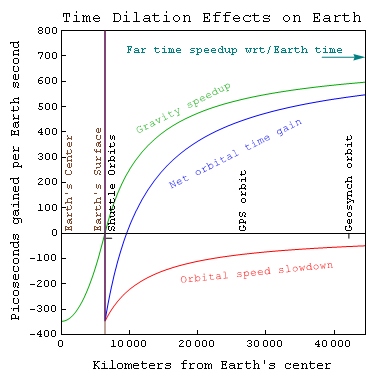Jimmyboy":3gywa61g said:
I'll try to answer your original post from December - I don't know enough about this to be sure I'm giving you the right answer, though. Hopefully, someone else will read this and correct any mistakes I make.
As I understand it, time for an atomic clock here on Earth at sea level passes a tiny bit slower than time for an atomic clock located in Denver at an elevation of 5,280 ft. More to the point of your question, I found the following passage [edited] in the Wikipedia article on GPS (global positioning system):
"...For example, the relativistic time slowing due to the speed of the satellite [is] about 1 part in 10^10 [and] the gravitational time dilation [on Earth] makes a satellite [clock] run about 5 parts in 10^10 faster than an Earth based clock..."
From this passage I'm guessing that the Earth's gravity causes a clock on its surface to run one-half second slow for every billion seconds counted by the clock in the GPS satellite - which, being in orbit around the Earth, could be considered a free-falling object in the Earth's gravitational field and, therefore, an inertial frame of reference. In this regard I believe the clock on the GPS satellite acts as if it's floating freely in space outside of any gravitational effects. One way to say this is that for every second the clock in the GPS satellite ticks off, the clock on the surface of the Earth ticks off 0.9999999995 seconds. A better way to say the same thing (for our calculation) is that for every second the clock on Earth ticks off a second, the clock in the GPS satelite ticks off 1/0.9999999995 seconds, or about 1.000000001 seconds.
If I understand your original question correctly, you want to know how fast a space ship which is not being effected by any gravitational field would have to go (in a direction away from Earth) in order for the clock on the space ship to run as slow as an identical clock on the surface of the Earth. There is a formula - called the Lorentz factor - by which this speed can be calculated. The symbol for the Lorentz factor is the lower case Greek letter Gamma - which looks like a curly "y". I'll just use
y since I don't how to make greek letters on my computer:
y(delta t)=1/sqrt[1-(v^2/c^2)]
In this case (delta t)=the seconds ticked off by the clock in the space ship (which we'll say is one second to simplify matters),
y=the Lorentz factor, [
y(delta t)]= the seconds ticked off by the "stationary" clock, v=the velocity of the space ship relative to Earth, c=the speed of light (~300,000 km/sec), and sqrt means square root.
We already know that we want the "staionary" clock in an inertial frame of reference (outside the influence of gravity) to run faster, relative to our space ship, by the same amount as the GPS clock does, relative to the clock on the Earth. This amount - or factor - is 1.000000001 seconds for every second on our space ship. In other words
y=1.000000001. Since we've said that (delta t)=1 second we can leave it out of the discussion. We also know that
y=1/sqrt[1-(v^2/c^2)]. To make this formula work we know that the "one" in the numerator on the right side is going to have to be divided by a number that's just a tiny bit smaller than one. As the original formula for the Lorentz factor suggests, this number is the reciprocal of 1.000000001 or 0.9999999995. This number is equal to the denominator on the right side of the equation, which is sqrt[1-(v^2/c^2)].
The square of 0.9999999995=~0.999999999. Since this=[1-(v^2/c^2)], then (v^2/c^2)=0.000000001 or (1 x 10^-9). Multiplying both sides by c^2 (9 x 10^10 km^2/sec^2) we wind up with v^2=90 km^2/sec^2 and, taking the square root of both sides we have v=~9.4868 km/sec.
If my calculation is right, then the space ship would have to be travelling about 21,200 mph for the clocks on the ship to match the clocks on Earth.
I have to caution you again that I probably don't know any more than you do about how these things are calculated. I may be using this formula entirely wrong and my math probably sucks. It's the best I can do. I sure hope someone else looks at this for your sake.
Chris



